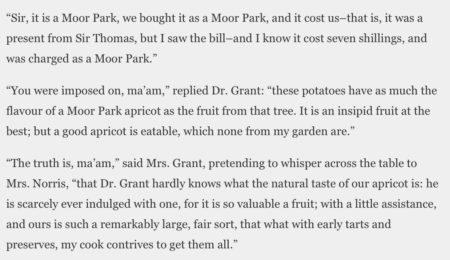So Plant Heritage tweeted a few days ago about the genera that are missing from the UK’s National Plant Collections.
The Missing Genera Campaign asks people with a passion for plants to put together a National Plant Collection of their own and join the Plant Heritage community in growing, sharing and saving plants.
One of the missing plants is the apricot, so I quickly checked on Genesys to see whether anyone else around the world has British apricots stashed away. Turns out there are two apricot varieties of British origin that are conserved in genebanks that publish their data on Genesys, a fact that I posted on Twitter too. Because, why not?

And that second one turns out to be rather special. As Plant Heritage quickly informed me, the Moor Park apricot is mentioned by Jane Austen in Mansfield Park, which was published about the time of the Battle of Waterloo.

Interestingly, the Moor Park apricot in Genesys is being conserved in Italy. But there must be other specimens in the UK, surely?